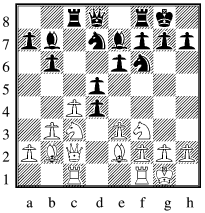
February 2014
Division 1
| ||||||||||||||||||||||||||||||||||||||||||||||||
Division 3
| ||||||||||||||||||||||||||||||||||||||||||||||||
Division 5
|
Division 2
| ||||||||||||||||||||||||||||||||||||||||||||||||||||||
Division 4
|
Macclesfield retain their grip on division two, with only Knights now looking capable of mounting a challenge. Alsager A picked up their first pointsof the season in January, but still look favourites for bottom spot even though Rooks and fenton A are both also finding points hard to come by.
The third division is still free of postponements, but nothing happened in January to dispel the idea that the division is a two horse race between Cheddleton E and Kidsgrove. With no significant gaps in the table between the other teams, both bronze medal and wooden spoon places are up for grabs.
Fenton B extended their 100% record to six matches, and with all other teams having dropped at least six points it would now be a major upset if Fenton failed to land the division four title. Tiny Pawns are rooted to the bottom of the table, but now at least have a point to show for their efforts. The rest seem capable of beating each other, so their final positions are still unpredictable.
The Meir teams continue to lead in division five, but can hardly claim to have broken free of their pursuers so that a brief loss of form on their part, or inspired play by their opponents could easily shake up the current order.
There was no cup action in January, the one such match scheduled being one of five games postponed.
January ia also the month in which new gardes are published, even though we stick to the old ones for league purposes. Ignoring those who played just one game in our competitions, there were ten North Staffs players whose grades went up by at least ten points. Thomas Robson of Macclesfield led the way with a 19 point gain, closely followed by Malcolm Roberts (Holmes Chapel, +18) and Julian Hawthorne (Kidsgrove +17). The other double digit advancers were Sam Beardmore, and Alex and Jacob Cartlidge, all of Cheddleton, George Scattergood (Holmes Chapel), Derek Northage (Kidsgrove), David Mallinson (Macclesfield) and Stephane Pedder (Stafford). Best wishes to them in their attempts to hold on to their gains.
comment on this article

|
| RR v Kevin Wilson after 11 ... cxd4 |
14 Bxe6 fxe6, 15 Nxe6 Qe8, 16 Nxf8 Qxf8, 17 Qe2 A queen move seemed called for, though this one takes a retreat square away from the knight. I reckoned Qd2 would ask for Rd8, and I'm looking to move my queen again. I wanted to play Qf5, but lacked the courage to move her so far into the open board with so many enemy minor pieces ready to harrass her.
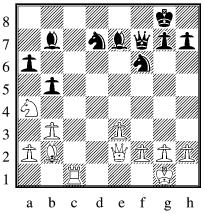
|
| RR v Kevin Wilson after 19 ... b5 |
Rc7 is now the move I want to play, but I'm concerned about Bxg2 before bxN4 opening up my king, but perhaps I should want more exchanges, particularly as it would break up his bishop pair. Anyway Nc3 can't be bad.
20 Nc3 Qg6, 21 f3 Bc5, 22 Kh1 Qh6, 23 Nd1 Rd1 is slightly better, though I wanted to keep my rook on an open file. e4 also considered.
23 ... Bd6, 24 h3 The alternative is f4. However both start opening up holes for his knights.
24 ... Ne5 The sensible move now is Nf2, the extra defender easing the pressure considerably. However RR is fixated on the g3 forking hole, so elects to create another square for his queen. Not the best decision he has ever made. After all he can even play Kg1 to evade the fork, also unpinning the h-pawn.
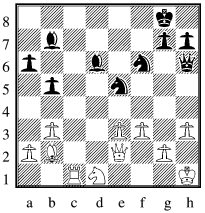
|
| RR v Kevin Wilson after 24 ... Ne5 |
26 ... Ng3+, 27 Kg1 Qxe3+, 28 Nxe3 Ne2+, 29 Kf1 Nxc1, 30 Bxc1 and I'm down a piece for two pawns. Moreover, he still has the bishop pair. Not healthy.
30 ... g6, 31 Ke2 Nc6, 32 Bb2 Be5, 33 Bxe5 No objections to removing the dark-squared bishops. Mine's doing next to nothing, whilst the presence of his restricts my knight. You never know I may be able to get down to a position in which he has the wrong bishop to force through his a-pawn.
. 33 ... Nxe5, 34 b4 Kf7, 35 a3 Although I don't want pawns on white squares this is premature - there are pawns on the other wing which could also usefully be moved into the dark.
35 ... Ke6, 36 Kd2 Nd7, 37 Kd3 Ke5, 38 g3 Nf6, 39 Ng4+ Nxg4
40 f4+ Kd6, 41 hxg4 Bc8, 42 g5 A move that either h6 or g5 from black would have prevented. Now I'm content for my king to hop between e3 and d4 for the rest of the game.

|
| RR v Kevin Wilson after 42 g5 |
RR escapes with his skin intact. Modern chess programs are exceedingly strong, but you can't afford to believe everything they tell you. Houdini 1.5 assesses the final position as -0.77, Fritz 9 as -1.20 and Stockfish 4 as -1.63. I'm not convinced that my human asssessment of 0.00 is not superior.
comment on this article
9 Bg3 Qd7, 10 e3 Nc6, 11 Nbd2 Nxg3, 12 hxg3 c4
13 Qg6+ Qf7, 14 Qh5 Bd7, 15 Be2 Qxh5, 16 Rxh5
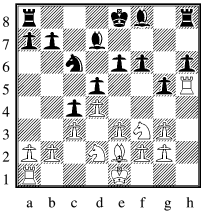
|
| Stephen Philp v RR after 16 ... Rxh5 |
16 ... 0-0-0, 17 0-0-0 g4, 18 Ne1 Be8, 19 Rh1 f5
20 e4 Na5, 21 e5 Ba4, 22 Nc2 Be7, 23 Rdf1 Rdg8
24 f3 gxf3, 25 Rxf3 Bg5, 26 Ne3 Looks like a man intent an saccing his way to a passed pawn.
26 ... Kc7, 27 Nxd7+ exd5, 28 Rxf5 Bxd2+ The bishop is doing a good job restricting white's forward possibilities, but RR couldn't resist making the material position a piece for a pawn instead of two.
29 Kxd2 Rxg3, 30 Rf7+ Kd8, 31 Bf3 Be8, 32 Rf6 Bc6
33 Rhxh6 Rxh6, 34 Rxh6 Rg7, 35 Rd6+ Kc7, 36 Rf6 b5
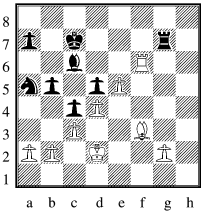
|
| Stephen Philp v RR after 16 ... Rxh5 |
37 ... Kd6, 38 Rf7 Rxf7, 39 exf7 Ke7, 40 Ke3 The f-pawn cannot be saved - Bh5 simply draws Bd7 and Be6 from black.
40 ... Kxf7, 41 Kf4 Ke6, 42 g4 Be8, 43 g5 Nc6
44 Bg4+ Kd6, 45 Bf5 Ne7, 46 a3 a5 taking the bishop must win, but RR believes life will be easier if he can create some pawn weaknesses first.
47 Bc2 Ke6, 48 Bd1 RR had hoped to exchange bishops on g6, after which runs out of moves that allow him to defend the g-pawn. With that gone the win is trivial. But Stephen declined to allow that line.
48 ... Bg6, 49 Bg4+ Kd6, 50 Bh3 Bc2, 51 Bg4 Bg6
52 Bh3 Be4, 53 Ke3 Nc6, 54 Bg4 b4, 55 Bh5 bxa3
56 bxa3 Ke7, 57 Bf3 hastening the end
57 ... bxf3, 58 Kxf3 Ke6, 59 Kf4 a4, 60 Kg4 the only way to hold the g-pawn, but now
60 ... Nxd4 the end is nigh, 61 g6 Kf6 0-1
comment on this article
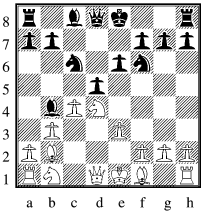
|
| RR v Roger Butters after 7 ... Bb4+ |
8 Bc3 Qa5, 9 Bxb4 (Qd2 is better though counter-intuitive as it invites Nd4. However
9 Qd2 Ne4, 10 Nxc6 Nxd2, 11 Nxa5 leads to black dropping a piece, whilst
10 ... Qb6, 11 Nxb4 Nxd2, 12 Nxd2 and white has three pieces for the queen)
9 ... Qxb4+, 10 Qd2 Nxd4, 11 exd4 awake enough not to play Qxb4
11 ... Qxd2+, 12 Nxd2 Bd7 diagram right
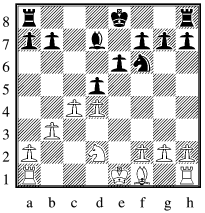
|
| RR v Roger Butters after 7 ... Bb4+ |
13 c5 Ke7, 14 Bd3 Rhc8, 15 Ke2 b6, 16 Ba6 Rc7, 17 b4 b5
The white bishop is cut off from play, but it is difficult for black to find a way of threatening to win it.
18 a4 Rb8, 19 Rhb1 Bc6, 20 Ra3 Nd7, 21 f4 Nf6
22 Rb2 Rd7, 23 Nf3 Rc7, 24 Ne5 Be8, 25 h3 Unnecessary. It really is time I opened the a-file with exchanges on b5
25 ... Ne4, 26 g4 f6, 27 Nf3 Surely Nd3, preparing to guard the b-pawn after exchanges on b5.
27 ... Bc6, 28 Nd2 Nxd2, 29 Kxd2 Kd7, 30 Re3 bxa4
31 b5 Kd7, 32 Ra3 chickening out of f5
32 ... Be8, 33 Rxa4 e5, 34 fxe5 fxe5, 35 Ke3 e4
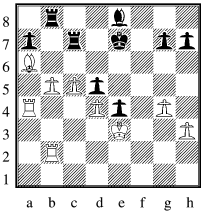
|
| RR v Roger Butters after 35 ... e4 |
36 Rab4 Bd7, 37 b6 axb6, 38 Rxb6 Ra8, 39 Bb7 Ra3+
Time to turn right.
40 R2b3 Rxb3+, 41 Rxb3 Bc6, 42 Bxc6 Rxc6, 43 Rb7+ Kf8 The king can't come forwards as
43 ... Kf6, 44 Rb6 is a simple win, whilst
43 ... Ke6, 44 Rxg7 and black loses both kingside pawn (h6 would simply lead to white removing the rooks and creating a passed kingside pawn to go with his passed c-pawn.
Kd8 might have provided more defence against the c-pawn, but the g and d pawns still both die.
44 Rd7 Rh6, 45 Rxd5 Rxh3+, 46 Kxe4 Rh4, 47 Kf4 Ke7, 48 Rh5 1-0
comment on this article
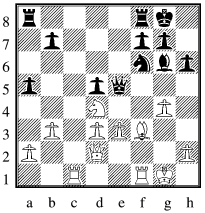
|
| RR v Ian Jamieson after 23 Rac1 |
24 gxh5 Bxh5, 25 Bxh5 Qxh5 Now to tell the black queen she is unwelcome:
26 Rf5 Qh3, 27 Rf3 Qd7, 28 Qg2 Ra6, 29 Nf5 diagram left
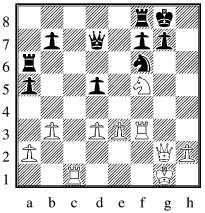
|
| RR v Ian Jamieson after 29 Nf5 |
29 ... Nh5 Pressure does strange things, and it seems unlikely that the black knight will be able to maintain its position here for long. Certainly this is the first move to be given an unequivocal thumbs down by my silicon friend. Of course Rg6 is threatened, so
30 Qh3 also threatening a knight check with discovered attack on the queen.
30 ... Rg6+, 31 Kf2 Now the ice has been broken in the bad moves department, RR throws one in. Kh1 was called for, but RR was not comfortable leaving his king with no legal moves.
31 ... Nf6 the only refutation of the twin threats of QxN and Nh6+ winning the queen.
32 Rf4 black can't allow Rh4 so
32 ... Rg4 and RR realises he should have played Kh1 earlier. With K on h1 this black rook move would cost the exchange as white can simply take it. However with the K on f2
33 Rxf2 Qxf5+ and black wins material. Naughty words!
33 Qf3 Rxf4, 34 Qxf4
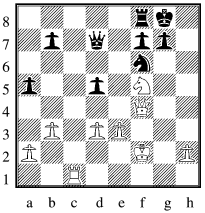
|
| RR v Ian Jamieson after 34 Qxf4 |
34 ... Rc8, 35 Rxc8+ 1-0
You don't need to be told why that's 1-0, do you?
comment on this article
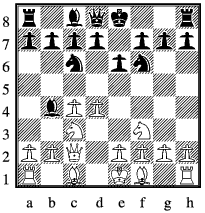
|
| RR v Ashwin Krishna after 5 Qc2 |
9 Ba3 temporarily preventing castling as he'd have no useful response to dxe5.
9 ... exd4. Although a self-pin, Qe7 would have been a better way of answering my threat. Now I have a substantial centre:
10 cxd4 Bg4, 11 Rd1 Bxf3 Either this guy likes knights, or he thinks multiple early exchanges would lead to a draw.
12 Bxf3 0-0, 13 0-0 Re8, 14 e5 dxe5 Knight move required - can't be right to allow me to open the d-file against his queen.
15 dxe5 Nd7, 16 Bxc6 Bxc6, 17 Qf5 Re6, 18 Qd3 With one black rook off his back rank I'm now certain of material gain even with my queen in front of my d-rook. As it should, the material proved decisive, even though Ashwin fought hard to create counter threats. However none of these derailed RR's progress, and black called it a day on move 65 with bare king against bishop and three pawns.
comment on this article
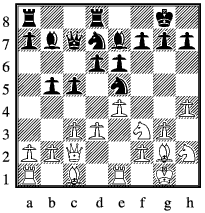
|
| Guido Baleani v RR after 14 h4 |
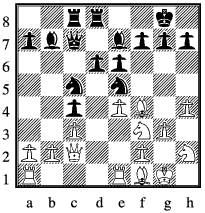
|
| Guido Baleani v RR after 17 ... Nc5 |
21 Bxe4 Bxe4, 22 Rxe4 fxe4, 23 Qxe4 Black emerges from the smoke an exchange for a pawn up, though has doubled isolated pawns. Black needs to create serious threats of disrupting the white pawns before white rounds up the e-pawns. Unfortunately his chosen route is not best.
23 ... Bf6, 24 Ng4 Qb6 Rb8 better. Best would have been to try to remove the queens with Qc4 as with queens off the black rooks become the dominant forces on the board.
25 Rb1 Qa6, 26 a3 Rc4, 27 Qe2 Had seen this pin and had intended Qc6 now, with Re4 to follow. But
27 ... Qc6, 28 Ngxe5 Bxe5, 29 Nxe5 Re4 loses to Nxc6 though
29 ... Qe4, 30 Qxc4 Qxb1+ allows black to emerge exchange for two pawns. But in this case those white pawns look superior. Should bale out with Ra4 or Rc6, but found myself continuing:
27 ... Qc8, 28 Ngxe5 Bxe5, 29 Nxe5 Rc5 and I've achieved nothing whilst dropping the first of my isolated pawns.
30 Re1 Rcd5, 31 Nf3 Rf8, 32 Ng5 Time for a big think as I should not have allowed this and don't want to make further errors. the trouble with big thinksthough is that having seen a move you can't play, you then dismiss other options and return to the original unplayable move. True to type RR does just this:
32 ... e5 (silent mental scream as he remembers why this is not playable)
33 Qe4 forking mate and the d5 rook. Admittedly Rfd8 briefly covers both, but I refuse to believe that I can survive the subsequent attack. Rambling rook has dropped a rook. Now he's just rambling, which amazingly he does for another 20 moves before doing the decent thing and resigning.
comment on this article
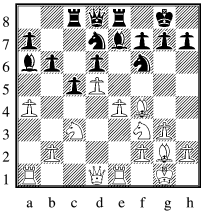
|
| RR v Tony Shaw after 13 ... Rc8 |
11 e5 dxe5, 15 Bxe5 Nxe5, 16 Nxe5 Bd6 With d-pawn blockaded black is comfortable
17 Nc6 Qc7 Lining queen and bishop up on b8h2 diagonal is not that threatening here. Better to take a pair of rooks off and play Qd7, ready for Re8
18 Nb5 Bxb5, 19 axb5 Ra8, 20 Qd2 White's turn to find an inferior line to taking off a pair of rooks - black can hardly recapture with the other rook as this gives up the a-pawn.
20 ... Qb7, 21 Ra6 Rxe1+, 22 Qxe1 Kf8 (diag right)
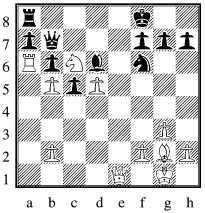
|
| RR v Tony Shaw after 22 ... Kf8 |
23 f4 Nd7, 24 Qe2 (Qa1 still works)
24 ... Nb8, 25 Ra3 a5, 26 Qh5 Kg8, 27 Re3 Nxc6
28 dxc6 Qc7, 29 Qe2 Kf8, 30 Bd5 a4, 31 Qc4 Ra7
32 Bf3 (Qd3 would have been very annoying for black to have to answer)
32 ... Qd8, 33 Rd3 Qf6, 34 Qd5 Be7 Bc7 is better. Although it cuts off the rook from defending, it blocks the c-pawn.
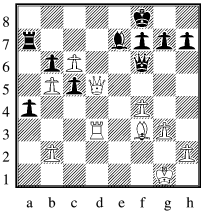
|
| RR v Tony Shaw after 34 ... Be7 |
36 c7 at last Rxc8, 37 Qa8+ 1-0
Always ahead, RR somewhat fell over the line. But a point's a point.
comment on this article
1 e4 d5, 2 d4 exd4, 3 f3 e5 I believe that the Blackmar-Diemer Gambit mainlines have 3 Nc3 for white, but I'm still not interested in giving him his pet position by taking on f3.
4 Be3 exd4, 5 Bxd4 c5, 6 Bc3 Qxd1+, 7 Kxd1 exf3
8 Nxf3 Bg4, 9 Bb5+ Nd7, 10 Re1+ Ne7, 11 Kc1 Bxf3+
12 gxf3 0-0-0 diagram
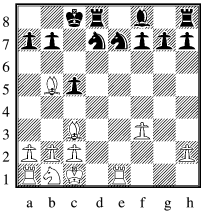
|
| Alan Ruffle v RR after 12 ... 0-0-0 |
We join the game with black having just developed his bishop to d7, rather than the b7 I had expected. Although I have a space advantage, black has chances of being annoying down the c-file. Nonetheless I feel it's a case of so far so good.
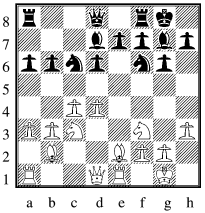
|
| RR v Gary Jackson after 13 ... Bd7 |
15 ... Nb7, 16 Nd4 Rc8, 17 Qb3 Subsequent examination shows that white can abandon this pawn with Bf3 since after
17 Bf3 Rxc4, 18 Nc6 not only is the rook is vulnerable, but more immediately so is the pawn on e7.
17 ... Re8, 18 Bf3 Qc7, 19 Nc6 e6, 20 b5 RR's first really bad move of the game, conceding c5 to an enemy knight. Whilst there are shades of my round three game with the knight on c6 finally being captured to give a supported passed pawn, it is surely better simply to centralise my other rook here.
20 ... Nc5, 21 Qd1 a5, 22 Na2 We're in buses territory here. wait 20 moves for a bad one, then a second follows almost immediately. Na4 would have ensured that the black c5 knight is not a long term problem. Whatever my thinking at the time, I now find it hard to discern any logic behind the chosen move.
22 ... e5, 23 Bg4 Talking of buses, here's a third one. Diagram right.
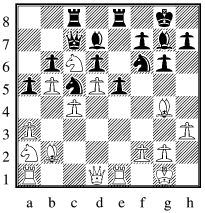
|
| RR v Gary Jackson after 23 Bg4 |
26 f4 trading poor moves. Bc1 holds the pawn.
26 ... exf4, 27 Bxg7 Kxg7 Clearly this poition is difficult to play, as we're both missing best moves. Taking on c6 with intent to capture on g7 with the queen is better. Black would then be a pawn up and control an important long diagonal.
28 Qd4+ Kg8, 29 Nc3 Ra8 Perhaps a move in the same category as my earlier Na2
30 Nxe4 fxe4, 31 Rxe4 Bf5, 32 Rxe4 Somehow I'm a pawn up, though doubled isolated doesn't seem best possible way of possessing that value.
32 ... Qg7 (left)

|
| RR v Gary Jackson after 32 ... Qg7 |
33 Qf6 Qxf6, 34 gxf6 Kf7, 35 g4 Re4, 36 Raf1 Rxf4
37 Rxf4 Bd3, 38 g5 Re8, 39 Ne7 Rh8, 40 Kf2 h5 I'm not taking that. Pawn up, supported passed pawn on sixth, and knight to go with my rook, traditionally a better pairing than bishop and rook. Yes, I need to keep an eye on his h-pawn, but even more I need to find a way into his position.
41 Ke3 Bc2 I'm now thinking in terms of c5 to create a passed pawn on the queenside. Indeed my silicon companion has been urging me to do this for some time. But I lack the courage as it gives him passed pawns on both wings too.
42 Rh4 Bd1, 43 Kf4 Bg4, 44 Kg3 Rb8 45 Rh1 Considered Rxg4 with c5 to follow at some stage, but decided I had other ways of making progress.
45 ... Be2= (right)
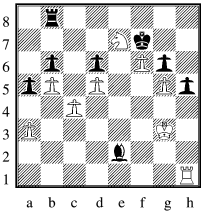
|
| RR v Gary Jackson after 45 ... Be2= |
46 Re1 Bxc4, 47 Rc1 Bxb5, 48 Rc7 Earlier I should have been saccing the c-pawn to create queenside play, now a double pawn sac gets my rook onto the seventh. can he survive this?
48 ... Re8, 49 Nf5+ Kf8, 50 Nxd6 Winning, but Nd4 much more powerful.
50 ... Re5, 51 Rh7 Rxg5+, 52 Kf2 Rf5+, 53 Nxf5 gxf5, but it is now simply a case of when will black resign, which turns out to be six moves later.
And so it came to pass that RR finished joint first with two others. If that doesn't boost his confidence, nothing will.
comment on this article